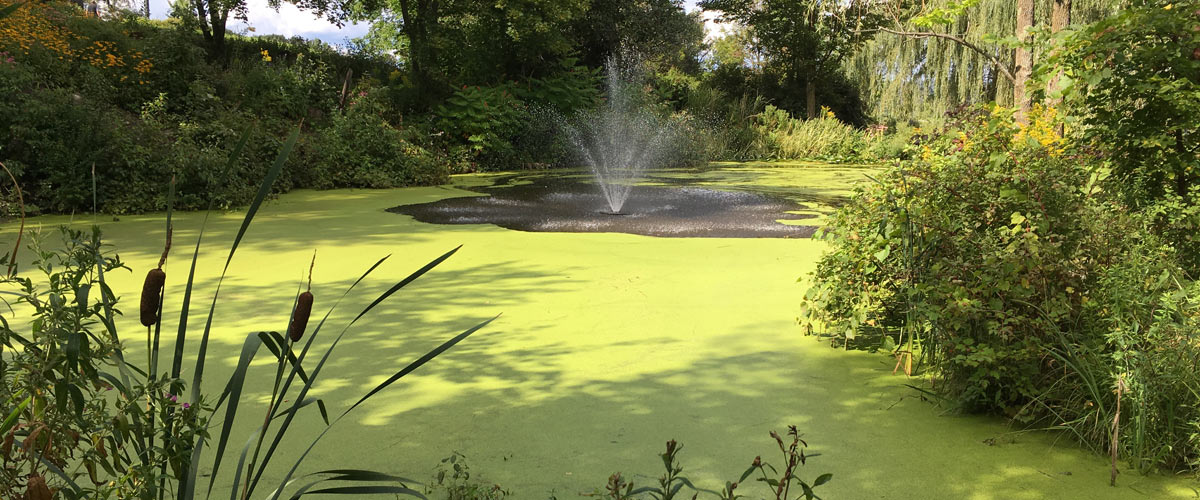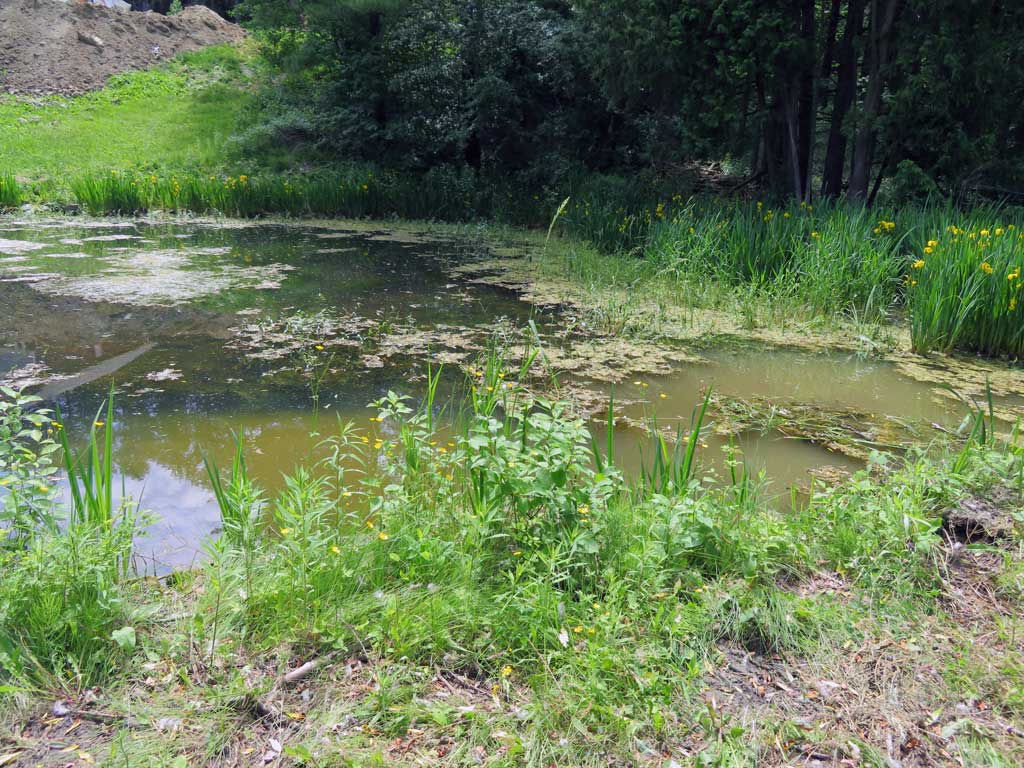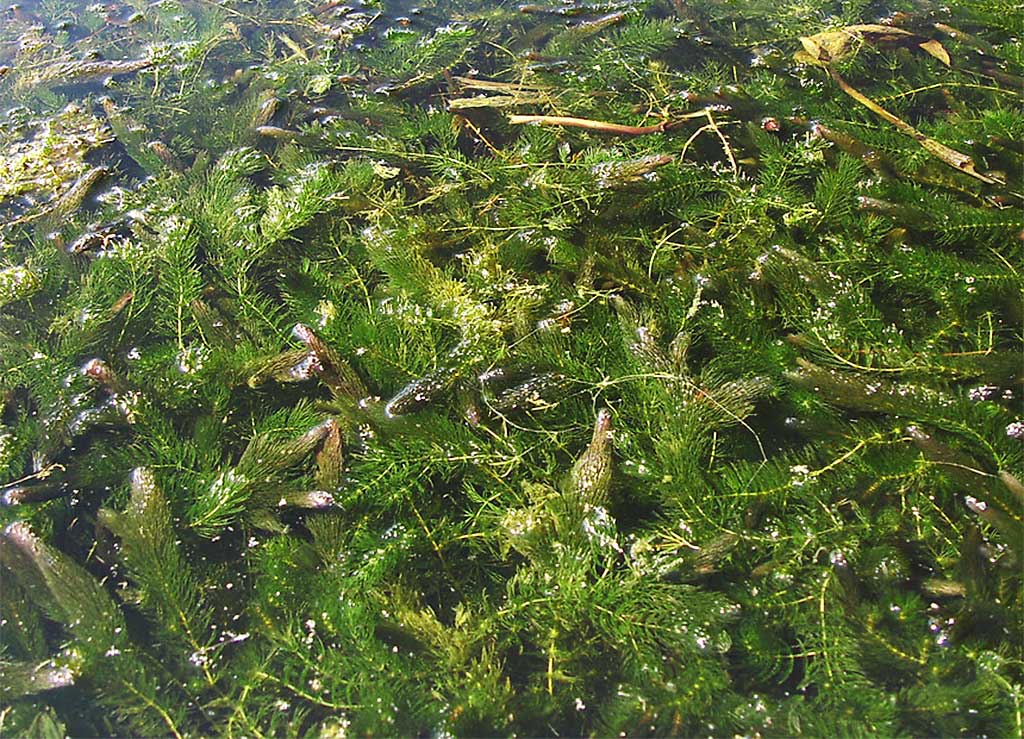There are several types of aquatic weeds and plants that grow in and around large, natural ponds. Submerged plants, such as coontail, elodea, water lilies grow in deeper water, usually up to 5′ deep. Emergent, or shoreline plants, such as cattails, bulrushes, irises , pickerel weed etc. grow around the margins of ponds, in water up to 2′ deep. Floating pond plants such as duckweed and watermeal (azolla, water hyacinth, salvinia in warmer climates) float on the surface of the pond. While most of these plants are beneficial to the pond ecosystem, they can grow very rapidly in nutrient rich ponds, and quickly become unsightly or unhealthy for the pond and its inhabitants. Once these plants get to this stage, we usually refer to them as pond weeds. If you have some shoreline or aquatic plants growing in your pond, but aren’t sure what they are, check out our handy Pond Weed & Plant Identification Guide.
In most cases, manual removal is the only way to control submerged or emergent weeds. It may seem like a monumental task, especially if you have a very large pond that has a lot of weed growth, but the results will be worth it. Plus, if you proactively manage the pond with proper pond treatments and aeration after a cleaning, you can drastically reduce the amount of weed re-growth in the future.
If you are looking to clean up your pond and have weeds or algae removed, have a fountain or aeration system installed, or would like to have an assessment of your pond done, take a look at our Large Pond Maintenance & Intallations for more information.
Once established in a pond, floating pond plants such as duckweed or watermeal can grow extremely quickly making the pond look very unpleasant. Duckweed can overtake a pond and completely cover the surface robbing the pond of light and oxygen.

Although some fish and waterfowl will eat duckweed, once it overtakes a pond, manual removal is the only way to quickly remove duckweed. Skimming the surface of the pond with a net or parachute skimmer works well, however, boats will likely be needed to reach all the duckweed in larger ponds.
A long term and long lasting approach is to reduce accumulated muck / sludge on the bottom of the pond with aeration and MuckOut, muck reducing bacteria. Reducing phosphates in the water with Lake Phosphate Binder, will starve the duckweed and works well to directly control it. 3 sizes are available.
Duckweed is a small free floating plant about 1/8″ to 1/4″ in diameter. Each plant usually has 2 or 3 light green leaves and a few small roots that hang below. Although it does produces seeds, it spreads very quickly in calm, still waters by division.
Both watermeal and duckweed are pictured above growing together. The duckweed is the larger of the plants, while the watermeal is the smaller plant. Watermeal is very tiny, each plant is about the of a pinhead. Even though both these plants are small, they can reproduce quickly in the right conditions (warm water, lots of nutrients) and completely cover a pond.
Emergent / Shoreline plants are one of the most common problem in ponds. Cattails, bullrushes, grasses, irises and phragmites can quickly become established in ponds with shallow shorelines in depths of up to 2 feet. Often, these plants initially colonise new ponds by seeds carried by wind, birds or other animals. Once established, many marginal plants can spread rapidly underground making them difficult to control.

Emergent plants pose a real problem in ponds, once they overtake an area, they are difficult to remove. Cattails are probably the most common emergent / shoreline weed, they grow very fast and have extensive root systems. In Canada, there are no herbicides available for spraying and killing weeds in and around ponds, so manual removal is the only answer. Weed rakes and cutters work well, but it is hard tedious work.
It is best to control weed species at the first sign of them, before they become established and cover a lerge area.
Yellow iris are a non-native plant originally introduced from Europe. They grow up to 4′ tall, produce an abundance of bright yellow flowers in the spring and have a fibrous root system. They don’t spread too quickly through their root system, however they can easily spread by seed. They grow in shallow water up to about 12″ deep.
Submerged pond weeds are common in large natural ponds. Some submerged plants are beneficial to your pond, however, in nutrient-rich ponds, they can grow very quickly and become unsightly and reduce circulation. They can also make it difficult to use the pond for swimming or recreation when they form dense mats. Common submerged weeds include coontail, elodea, curly leaf pond weed and milfoil.

If you have excessive weed growth in your pond, the most effective way to remove them is by manual removal. Weed Rakes and Cutters are extremely useful tools for removing submerged pond weeds. They can be used to cut and drag weeds to the shore where they can be removed. If you have moderate growth of submerged weeds, Pond Dyes can be very effective at reducing growth if used early in the spring before the plant start actively growing.